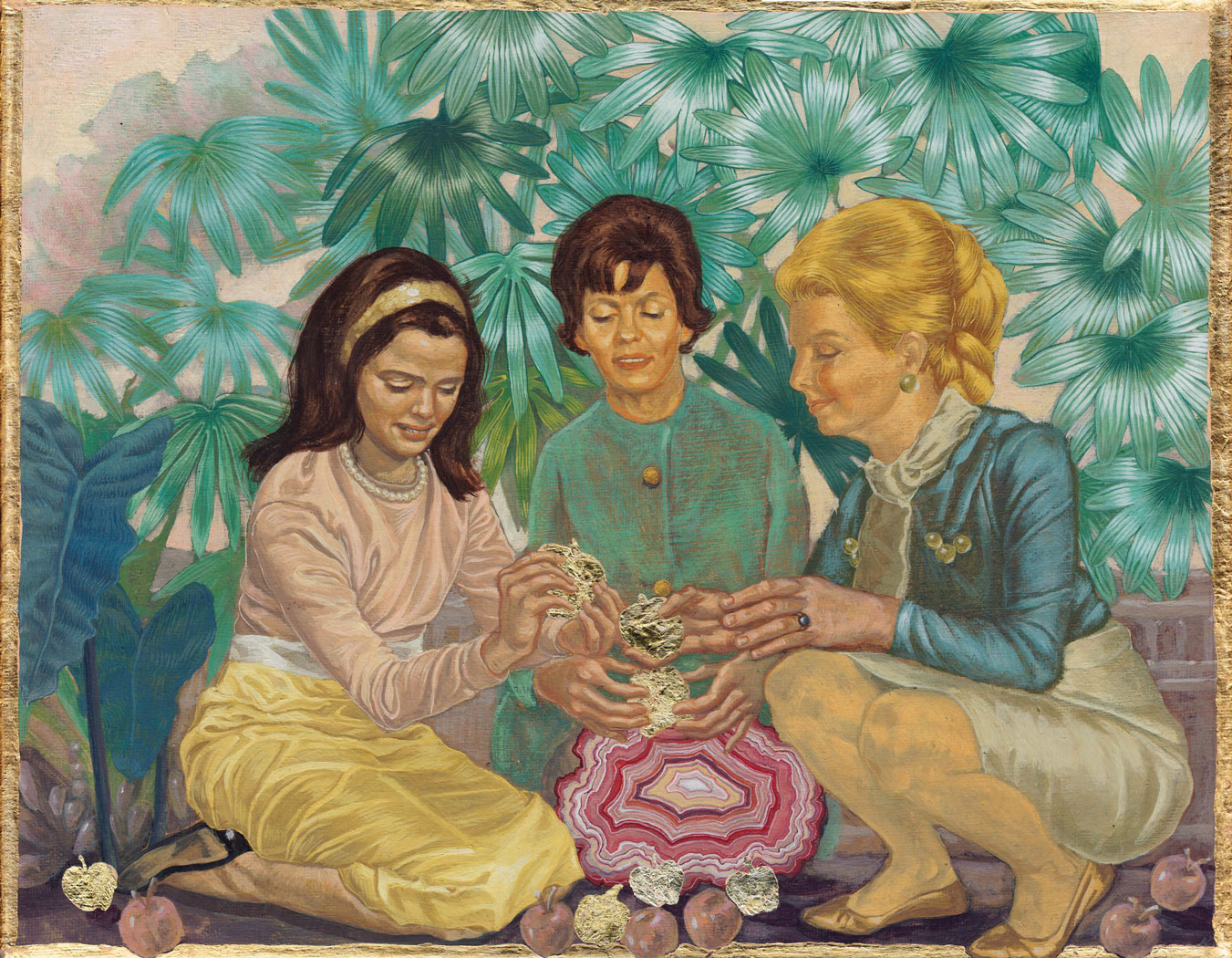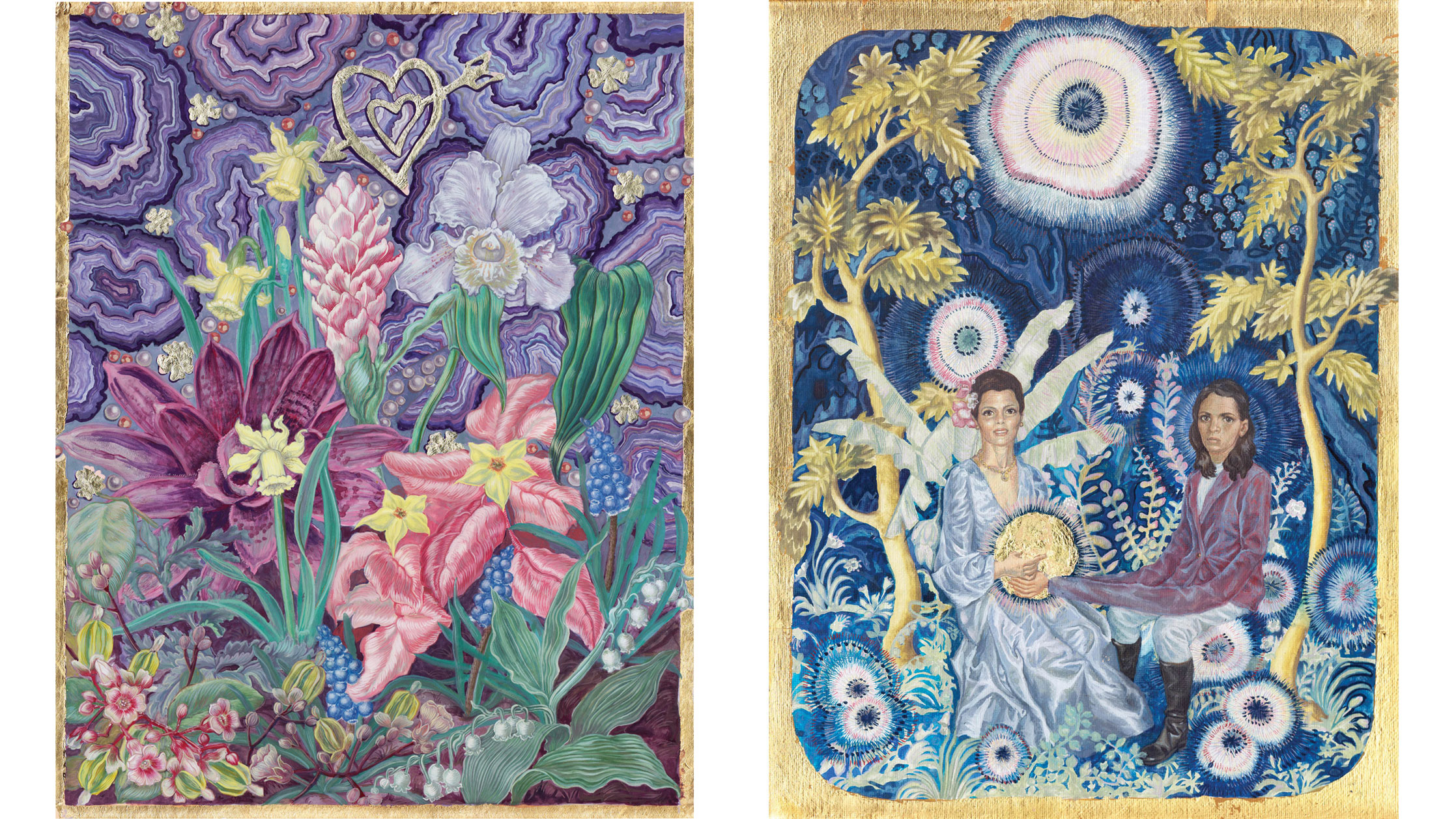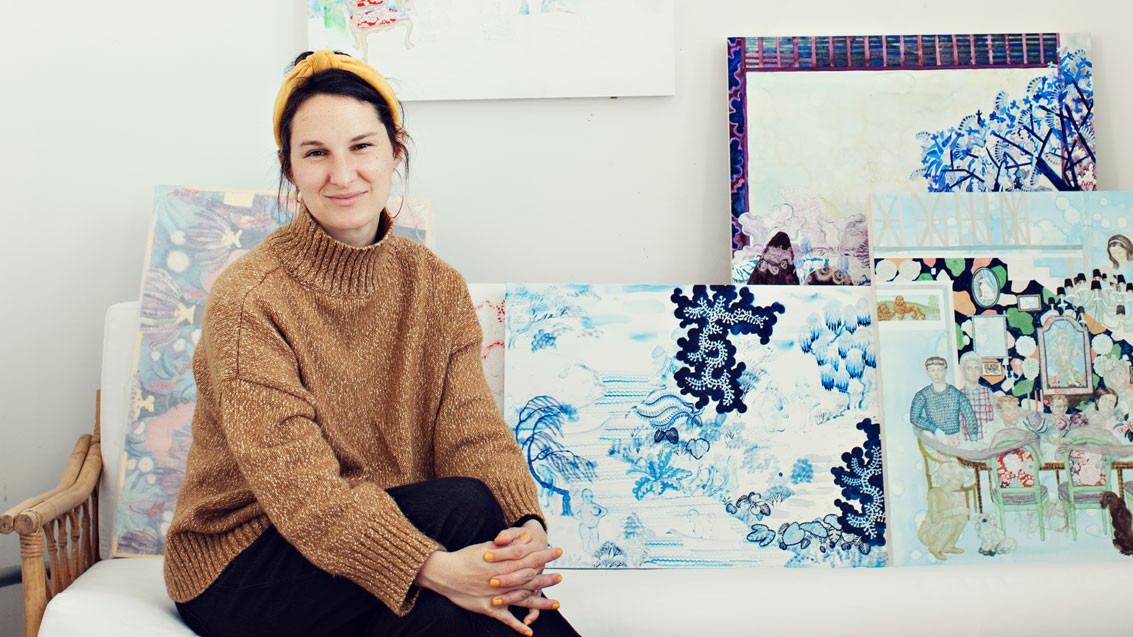Painter Larissa Bates ’99 explores connection & culture
The paintings of Larissa Bates ’99 draw inspiration from many parts of her life story—from the death of her mother, her half-Costa-Rican-half-Vermonter heritage, and her fascination with topics such as colonialism, family, power, and identity. But even as an artist who has exhibited internationally and a mother of two living outside New York City, Bates has connections to Williston that run deep.
Observers of her work will find people depicted semirealistically in lush, botanically detailed settings. Some humans have impossibly long arms that twine around others. Bates dips her brush again and again into Tyrian purple, a color with historical resonance (the ancient Phoenicians were the first to extract it in a labor-intensive process from the mucus of predatory sea snails, she explained; its use in dyed cloth conferred status on the wearer). The images recall the bright, ornate miniatures of 16th-century India and Persia—figures sitting still, posed, realistic but intentionally flat.
Bates’ most recent body of work, 2019’s “Las Doñas”—in English, “The Grand Dames”—was created with gouache on paper, often with crinkly gold leaf and lustrous mother-of-pearl worked in. Her work has hung in galleries around the world and been reviewed in The New York Times and The New Yorker, as well as publications in China, Sweden, and Spain.
The universe of images serves as a jumping-off point to get to know the artist. Bates was raised in Warren, Vermont, by her father, a “flatlander,” she said, “who went to live off the land in the 1970s. We didn’t have electricity until I was 10.”
Before she was born, her dad—by turns, a painter, a stone mason, and a construction worker—traveled to Costa Rica to maintain a property his friend owned. While there, he met Bates’ mother. The two married, and within three months of Bates’ birth, her mother died. The tie that binds her to her mother’s family is strong, and she examines that relationship in her work.
“I use painting to explore her identity,” she said.
But that’s just the beginning. Bates digs deep into the power structures that allow for colonialism and exploitation. In her mother’s family tree, which includes descendants from the U.S. and Costa Rica, was a relative who worked for the United Fruit Company, the precursor of Chiquita Banana. The company is known as the first multinational corporation, which used its influence to exert control over many aspects of life in countries in South and Central America.
The iconography in Bates’ work calls out both overt, and more subtle, dynamics of colonialism. Take the daffodils that dot many of her lush, tropical tableaux. After reading an essay on Jamaica Kincaid’s novella Lucy Bates wanted to explore Kincaid’s idea about dislocation and cultural erasure. Kincaid’s title character, raised in the West Indies, is, as a child, forced to memorize the English poet William Wordsworth’s famous poem “I Wandered Lonely as a Cloud,” in which he stumbles upon a glorious view of ten thousand daffodils.
The flower, native to Europe, did not grow on Lucy’s home island, and,
in the story, the exercise of reciting the poem made her realize how toxic colonialism can be.
Bates plants narcissus bulbs in her paintings; incongruously the daffodil blossoms bob among the wide banana leaves and twisting vines, telling a story that also helps her make sense of her life. “I am interested in these points of contact between my mother’s Latin heritage and my predominantly Anglo upbringing,” she noted.
Another subject of Bates’ exploration of her identity: The anatomically exaggerated arms of her subjects. They signify the aspects of her mother’s family that “reflect the Latinx idea of familismo, of the importance of family and a sense of a collectivist society,” she said. Familismo, a concept brought to her by a friend from Guatemala, means “always having hands to guide you and catch you, for better or worse,” she added.
“After my mother passed, her mother wanted to raise me in Costa Rica, as a Tica [or native Costa Rican]. The idea that there could have been an entirely different Larissa interests me—as does the way in which culture shapes us: our language, our religions, how we conceive of family, our prescribed gender roles, our entire understanding of reality.”
As a youth back in Vermont, Bates, was urged by a neighbor, the late Ray Montgomery ’54, author of the “Choose Your Own Adventure” stories, to visit Williston. The arts program lured her in. “Marcia Reed was wonderful,” she said, “and the huge windows!” She also met her future husband, Williston Athletic Hall of Fame wrestler David Bartlett Bates ’02. He is now a cancer researcher at Memorial Sloan Kettering Cancer Center.
Bates went on to study art at Hampshire College. During a visit to New York City, she happened to meet Monya Rowe at an alternative art space in New York City where Bates’ work was being shown. Rowe was starting a gallery in the city, and the two spawned a professional collaboration. Rowe has been showing Bates’ work since that meeting.
Bates now lives in Hastings-on-Hudson, New York, with her two children, Pilar, 10, and Sebastian, 4, and David.
“I have deep gratitude for the forces that brought us together,” she said.
Eight years ago, David, then a medical resident, noticed a lump in her breast and got her prompt cancer treatment. The early discovery led to Bates’ full recovery; however David also picked up on a subsequent missed diagnosis. This life event steered David to research cancer, a turn that has been the right choice for them. “He saved my life twice,” Bates said. “He’s my guardian angel.”
Now busy in her studio, which overlooks the Hudson River and Palisades beyond, Bates dreams about visits to the Cloud Forest in Costa Rica, where “moss grows on everything and plants grow on plants.” However, living near New York City fulfills a deep need to be a part of a creative environment. “I’m happiest in nature,” she said, “but it’s very different to be in New York City. There’s so much art!”

Bits of 22-carat gold leaf dot this painting from the 2015 series Mamá Lengua: Mother Tongue called As Tica as McIntosh Manzanas: Exotifying you Exotifying me

Left: I Wandered Lonely as a Cloud: After Jamaica Kincaid’s Reflections on Wordsworth
Right: From Mamá Lengua: Mother Tongue, Two Ubumes as Twin Gestational Carriers after the Two Fridas;

